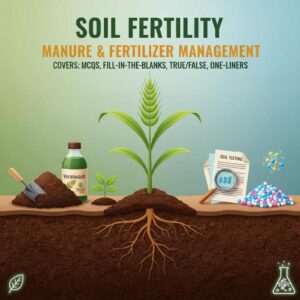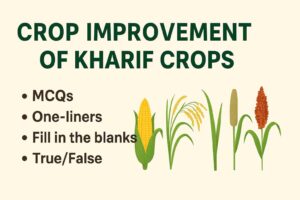Fundamentals of Agronomy MCQs
Agronomy is a core subject for every agriculture student, but many times, even after understanding the theory, there is confusion in exams. In this blog, I have given important fundamentals of agronomy MCQs, which cover the most relevant topics of the syllabus.
You will get a short, easy-to-understand explanation after every question, so that the concepts become clear and a strong base can be formed for competitive exams.
Let’s test and strengthen your basics—read each question, understand it, and move ahead confidently.
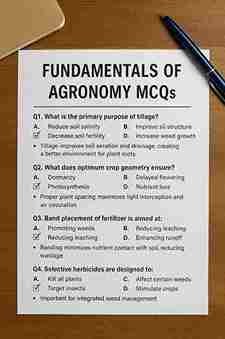
1. What is the ideal condition of soil for better seed germination and root development?
A. Hard and compact soil
B. Powdery and dry soil
C. Well-pulverised and moist soil
D. Waterlogged soil
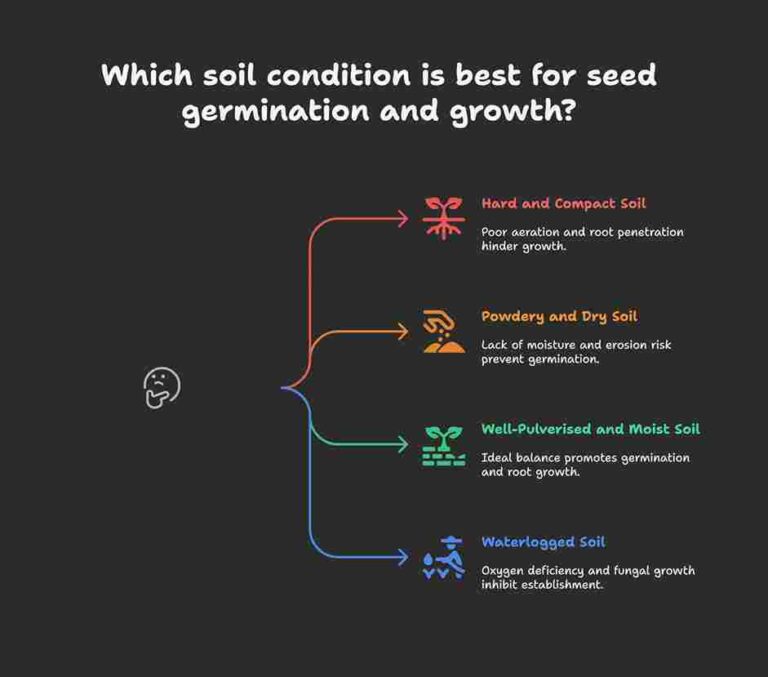
📝 Additional Information
Explanation (Main Answer):
This condition ensures
Good seed-soil contact for faster germination.
Adequate moisture to initiate metabolic activity.
Sufficient aeration for root growth.
A. Hard and compact soil
❌ Poor aeration leads to less oxygen for seeds.
❌ Difficult for roots to penetrate.
❌ Slows down germination and stunts growth.
B. Powdery and dry soil
❌ Lacks moisture; the seed may not imbibe water.
❌ Prone to erosion and crust formation.
❌ Not supportive of early root establishment.
C. Well-pulverised and moist soil
✅ Maintains ideal water and air balance.
✅ Promotes uniform germination and growth.
✅ Encourages deep root penetration and anchorage.
D. Waterlogged soil
❌ Oxygen deficiency in the root zone.
❌ May cause fungal growth and seed rot.
❌ Leads to poor stand establishment.
2. What is the ideal depth of sowing for most field crops like wheat and rice?
A. 1–2 cm
B. 5–7 cm
C. 10–12 cm
D. More than 15 cm
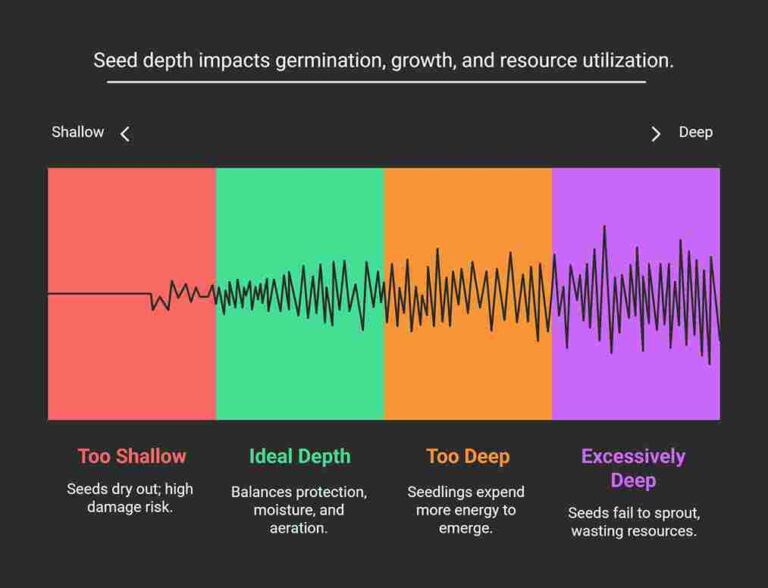
📝 Additional Information
Explanation (Main Answer):
Why is 5–7 cm ideal?
🌱 Perfect balance: It’s deep enough to protect seeds from birds but shallow enough to let seedlings emerge quickly.
💧 Moisture zone: At this depth, seeds get consistent soil moisture, essential for germination.
🌬️ Good aeration: Soil isn’t too compact, allowing oxygen to reach the growing embryo.
🧠 Option-wise Breakdown
A. 1–2 cm
🔹 Too shallow—seeds might dry out quickly under the sun.
🔹 High risk of damage from birds or insects.
🔹 Seedling instability due to weak anchorage.
B. 5–7 cm ✅
🔹 Ideal for cereals like wheat, rice, and barley.
🔹 Supports quick germination and strong root growth.
🔹 Helps reduce seedling mortality.
C. 10–12 cm
🔹 Too deep—seedlings use more energy to emerge.
🔹 Less oxygen—chances of rotting increase.
🔹 Germination rate drops drastically.
D. >15 cm
🔹 No field crop needs this depth.
🔹 Seeds can fail to sprout altogether.
🔹 Waste of seeds and time.
3. What happens if crop density is too high in a field?
A. Plants get more sunlight
B. Weed growth increases
C. Resource competition increases among plants
D. Soil fertility improves
📝 Additional Information
Explanation (Main Answer):
High crop density effects:
☀️ Less light penetration to lower leaves → poor photosynthesis.
💧 Water and nutrients get shared → stunted growth.
🌾 Plants compete → low yield & quality.
🧠 Option-wise Breakdown:
A. Plants get more sunlight
❌ Opposite—more crowding = less sunlight for lower leaves.
B. Weed growth increases
❌ Dense crops suppress weeds due to canopy cover.
C. Resource competition increases. ✅
✔️ Plants fight for nutrients, sunlight, and water.
✔️ Weakens individual performance.
D. Soil fertility improves
❌ More plants = more nutrient extraction, not fertility improvement.
4. Which of the following improves nutrient use efficiency (NUE) in crops?
A. Overuse of fertilisers
B. Broadcasting fertilizers randomly
C. Using slow-release or site-specific fertilizers
D. Applying water after nutrient leaching
📝 Additional Information
Explanation (Main Answer):
How NUE is improved:
🌿 Slow-release fertilisers reduce losses due to leaching or volatilization.
📍 Site-specific management ensures nutrients go where needed.
💰 Improves yield + reduces wastage and cost.
🧠 Option-wise Breakdown:
A. Overuse of fertilisers
❌ Leads to luxury consumption or runoff—wasteful & harmful.
B. Broadcasting randomly
❌ Uneven distribution—some plants get more, others less.
C. Slow-release/site-specific fertilisers ✅
✔️ Improve uptake timing & efficiency.
✔️ Reduce environmental harm.
D. Applying water after leaching
❌ Nutrients are already lost—water application won’t help.
5. Which of the following is a scientific method for irrigation scheduling?
A. When water is available
B. Fixed interval irrigation
C. Based on crop water requirement (CWR) and growth stage
D. Rainfall prediction only
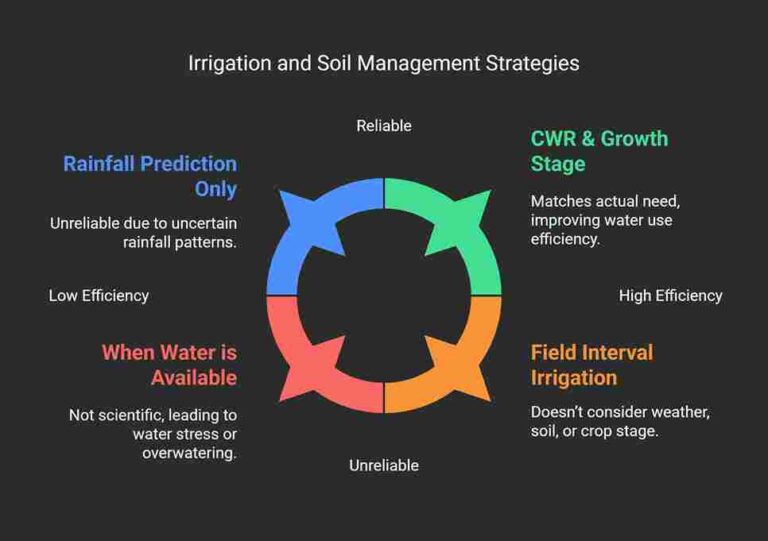
📝 Additional Information
Explanation (Main Answer):
Why is this best?
💧 Each crop needs a different amount of water at different stages.
🌱 Irrigating at critical stages (e.g., flowering) increases yield.
🎯 Avoids under- or over-irrigation.
🧠 Option-wise Breakdown:
A. When water is available
❌ Not scientific—can lead to water stress or overwatering.
B. Fixed interval irrigation
❌ Doesn’t consider weather, soil, or crop stage.
C. CWR & growth stage ✅
✔️ Matches actual need—improves water use efficiency.
✔️ Saves water and gives better yield.
D. Rainfall prediction only
❌ Unreliable—rainfall is uncertain.
soil science MCQ
6. Which principle is NOT part of integrated weed management?
A. Cultural practices
B. Mechanical control
C. Ignoring weeds in the initial stages
D. Chemical control
📝 Additional Information
Explanation (Main Answer):
What is Integrated Weed Management (IWM)?
⚙️ Uses multiple methods—cultural, mechanical, biological, and chemical.
🕰️ Weeds must be managed from the early stages, or else they dominate.
🌾 IWM is cost-effective and eco-friendly.
🧠 Option-wise Breakdown:
A. Cultural practices
✔️ Crop rotation and mulching prevent weed germination.
B. Mechanical control
✔️ Manual weeding, hoeing – effective in small farms.
C. Ignoring initial weeds ❌
❌ They compete heavily early—they must be controlled fast.
D. Chemical control
✔️ Herbicides like atrazine and 2,4-D are used.
7. What does "herbicide selectivity" mean?
A. Ability to kill all types of plants
B. Ability to target only weeds without harming the crop
C. Speed at which weeds die
D. Method of herbicide application
📝 Additional Information
Explanation (Main Answer):
Selectivity means
Herbicides are designed to kill specific weed species.
They are safe for the crop being grown.
E.g., 2,4-D kills broadleaf weeds but not grasses like wheat or rice.
🧠 Option-wise Explanation:
A. Kill all types of plants. ❌
That’s a non-selective herbicide (e.g., glyphosate).
Not safe for crops.
B. Only weeds, not crops. ✅
✔️ E.g., atrazine is used in maize but not in pulses.
✔️ Key for crop safety + effective weed control.
C. Speed of action ❌
Irrelevant to selectivity—that’s about contact or systemic action.
D. Method of application ❌
Spraying or soil application is not about selectivity.
8. Continuous use of the same herbicide may lead to what problem?
A. Soil erosion
B. Increased weed germination
C. Herbicide resistance in weeds
D. Higher crop yield
📝 Additional Information
Explanation (Main Answer):
Resistance develops when:
Weeds adapt genetically to survive herbicide applications.
Over time, those that survive reproduce → a more resistant population.
E.g., Phalaris minor resistant to isoproturon in wheat fields.
🧠 Option-wise Explanation:
A. Soil erosion ❌
Not directly related to herbicide use.
B. Increased weed germination ❌
Resistance is due to survival, not germination rate.
C. Herbicide resistance ✅
✔️ Like antibiotic resistance in bacteria.
✔️ Major issue in modern agriculture.
D. Higher crop yield ❌
Resistance leads to lower yield due to surviving weeds.
9. Which factor does NOT affect crop water requirement (CWR)?
A. Crop type and growth stage
B. Weather conditions
C. Farmer’s income
D. Soil type
📝 Additional Information
Explanation (Main Answer):
What affects CWR?
🌡️ Weather (evaporation, humidity)
🌱 Crop species and their stage (vegetative, flowering)
🪨 Soil type (sandy needs more frequent irrigation)
🧠 Option-wise Explanation:
A. Crop type & stage ✅
✔️ E.g., rice needs more water than wheat.
✔️ The flowering stage is most sensitive.
B. Weather conditions ✅
✔️ High temperature = high transpiration = more water needed.
C. Farmer’s income ❌
🚫 Income doesn’t change how much water a crop needs.
D. Soil type ✅
✔️ Clayey soil holds water longer; sandy soil drains faster.
10. What is the correct difference between "growth" and "development" in plants?
A. Growth refers to age; development refers to yield
B. Growth is quantitative; development is qualitative
C. Growth is seen in fruits only
D. Growth happens at night only
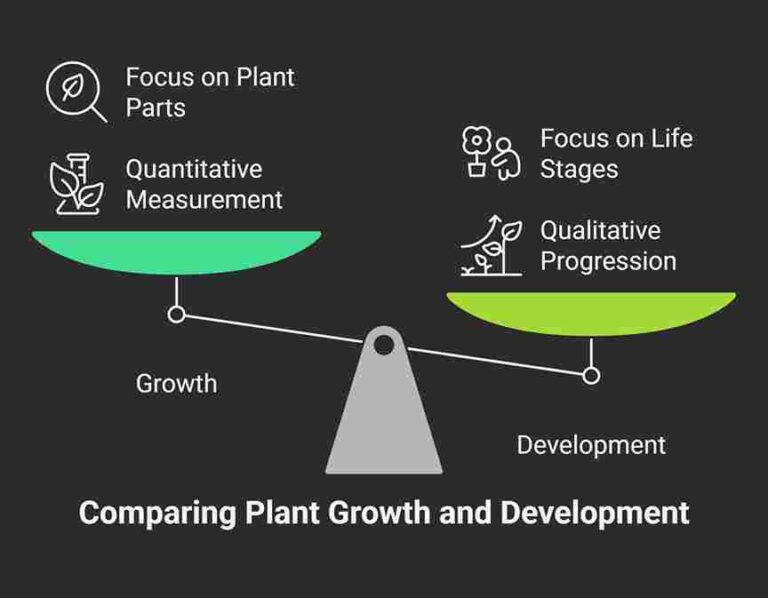
📝 Additional Information
Explanation (Main Answer):
Main difference:
Growth = increase in size, weight, or number (measurable).
Development = progression through stages (germination → flowering → maturity).
🧠 Option-wise Explanation:
A. Growth = age? ❌
Not age-based. Even old plant parts may grow.
B. Quantitative vs Qualitative ✅
✔️ Growth: plant height, leaf number.
✔️ Development: flowering, fruiting, senescence.
C. Fruits only? ❌
Growth occurs in all plant parts—roots, stems, and leaves.
D. Night only? ❌
🌞 Light is essential—though some parts grow at night, it’s not exclusive.
11. Which is NOT a benefit of proper crop rotation?
A. Better soil fertility
B. Pest and disease control
C. Increased weed resistance
D. Improved soil structure
📝 Additional Information
Explanation (Main Answer):
Why rotation is useful:
🌾 Changing crops breaks pest and disease life cycles.
🧪 Improves soil nutrient balance.
🚫 Helps reduce weed problems, not increase them.
🧠 Option-wise Explanation:
A. Soil fertility ✅
✔️ Legumes fix nitrogen, boosting fertility.
B. Pest control ✅
✔️ Different crops = no continuous pest host.
C. Weed resistance ❌
✖️ Rotation reduces resistance, not increases it.
D. Soil structure ✅
✔️ Different root systems improve porosity and structure.
12. What is meant by Water Use Efficiency (WUE) in crop production?
A. Amount of water used for irrigation
B. Ratio of crop yield to water consumed
C. Frequency of irrigation
D. Depth of water applied per irrigation
📝 Additional Information
Explanation (Main Answer):
Water Use Efficiency:
Measures how effectively a plant converts water into yield.
WUE = Yield (kg/ha) / Water used (mm or m³)
High WUE crops: millet, sorghum.
13. What is a “Plant Ideotype”?
A. The tallest variety of a crop
B. A theoretical model of an ideal plant type
C. A plant with high disease incidence
D. A plant suitable for only hilly areas
📝 Additional Information
Explanation (Main Answer):
Plant Ideotype:
Concept by Donald (1968)
Means “an ideal plant architecture” with traits like
Short height
More erect leaves
High harvest index
Resistance to pests
🧠 Option-wise Explanation:
A. Tallest variety ❌
✔️ Dwarf crops like semi-dwarf wheat (Norin 10) are preferred.
B. Ideal model ✅
✔️ “Ideotype” = “Ideal Type”
✔️ Used in crop breeding to improve yield.
C. High disease incidence ❌
The opposite of ideal—ideotype should have disease resistance.
D. Only for hilly areas ❌
Ideotype = universal concept for all regions.
14. Which is a common crop management strategy in saline soils?
A. Application of sodium chloride
B. Use of salt-sensitive crops
C. Incorporation of green manures
D. Use of high pH irrigation water
📝 Additional Information
Explanation (Main Answer):
Why green manures help:
Improve organic matter and soil structure, and reduce the salinity effect
Crops like Dhaincha and Sesbania are ideal
Help improve microbial activity
🧠 Option-wise Explanation:
A. Sodium chloride application ❌
✖️ Increases soil salinity—damaging!
B. Salt-sensitive crops ❌
✖️ These will fail in saline soils.
C. Green manures ✅
✔️ Reduce salt concentration naturally
✔️ Boost soil health and aeration
D. High pH irrigation water ❌
✖️ It worsens alkaline soil problems
15. What is allelopathy?
A. Use of chemical herbicides
B. Effect of one plant’s chemicals on another
C. Soil erosion by plant roots
D. Pest infestation due to chemicals
📝 Additional Information
Explanation (Main Answer):
Allelopathy:
Biochemical interaction between plants
Some plants release allelochemicals that suppress/inhibit nearby plant growth
E.g., Sorghum releases sorgoleone that inhibits weeds.
🧠 Option-wise Explanation:
A. Use of herbicides ❌
Allelopathy is natural, not synthetic.
B. Plant chemical effect ✅
✔️ Could be positive or negative
✔️ Important in weed control studies
C. Soil erosion ❌
Not related to chemical interaction.
D. Pest infestation ❌
Allelopathy is about plant-plant effects, not pest-plant.
16. What is the ideal moisture content of grains at the time of harvesting?
A.40–50%
B. 30–40%
C. 20–25%
D. 20% or below
📝 Additional Information
Explanation (Main Answer):
Moisture content & harvesting:
If grains are harvested at high moisture, fungal attack and spoilage risk increase.
The ideal range is 18–20% or less, depending on the crop.
Further drying is needed before storage.
🧠 Option-wise Explanation:
A. 40–50% ❌
There is a very high risk of fermentation and mold.
B. 30–40% ❌
Still unsafe for storage and threshing.
C. 20–25% ❌
Slightly better, but still needs more drying.
D. 20% or below ✅
✔️ Safe for harvesting, threshing & storage.
✔️ Reduces post-harvest losses.
Do you know Upcoming agriculture exams 2025
17. During which crop growth stage is the crop most vulnerable to weed competition?
A. Germination stage
B. Critical stage
C. Maturity stage
D. Post-harvest stage
📝 Additional Information
Explanation (Main Answer):
Critical Stage of Weed Competition:
It is the most sensitive phase when weed removal is crucial for yield.
Usually occurs 15–45 days after sowing, depending on the crop.
Weed competition during this stage significantly reduces yield.
🔎 Option-wise Explanation:
A. Germination stage
Crops and weeds both germinate, but competition is not yet intense.
Crop energy is still low; it’s too early.
B. Critical stage ✅
The key phase when weed control directly affects crop productivity.
Removing weeds during this window ensures maximum yield benefit.
C. Maturity stage
By this time, the crop has already set yield; weeds have minimal impact.
D. Post-harvest stage
Weeds may grow, but they no longer compete with the crop.
18. Which of the following is a commonly used method to schedule irrigation in crops?
A. Using wind speed
B. Measuring plant height
C. Monitoring pan evaporation
D. Checking rainfall forecast only
📝 Additional Information
Explanation (Main Answer):
Pan Evaporation Method:
Irrigation is scheduled when the cumulative pan evaporation = IW/CPE ratio.
Common IW/CPE ratios: Wheat—0.9, Groundnut—0.8
Scientific and widely used in research & large-scale agriculture.
🔎 Option-wise Explanation:
A. Wind speed
Wind affects evapotranspiration but is not used alone for scheduling.
B. Plant height
Indicates growth, not water need. Indirect and unreliable.
C. Pan evaporation ✅
Reliable method using Class A pan evaporimeter.
Helps maintain optimal soil moisture levels.
D. Rainfall forecast only
Useful but unpredictable. Not a stand-alone method.
19. Which practice improves nutrient use efficiency in crops?
A. Broadcasting fertilisers randomly
B. Applying excess water
C. Using split application of fertilisers
D. Using only organic manures
📝 Additional Information
Explanation (Main Answer):
Nutrient Use Efficiency:
NUE = Crop yield per unit of nutrient applied
Split application: prevents leaching, synchronises with crop demand
E.g., Urea applied in 2–3 splits in paddy/wheat
🔎 Option-wise Explanation:
A. Broadcasting randomly
Leads to uneven distribution, runoff, and wastage.
B. Excess water
Causes leaching of nutrients, especially nitrogen.
C. Split application ✅
Maximizes nutrient uptake efficiency.
Reduces losses through leaching or volatilisation.
D. Only organic manures
Improves soil health, but alone may not meet crop demand efficiently.
20. Which statement is true regarding manures compared to chemical fertilizers?
A. Manures are highly concentrated in nutrients
B. Manures improve soil structure and microbial activity
C. Manures cause quick nutrient release
D. Manures are synthetic substances

📝 Additional Information
Explanation (Main Answer):
Benefits of Manures:
Improve soil organic matter, porosity, and microbial population
Release nutrients slowly and sustainably
Examples: FYM, compost, green manure
🔎 Option-wise Explanation:
A. Highly concentrated nutrients
False—manures are dilute in nutrients compared to fertilisers.
B. Improve structure. ✅
True—manures enhance soil texture, moisture retention, and life.
C. Quick nutrient release
False—manures release nutrients slowly over time.
D. Synthetic substances
False—manures are natural or organic in origin.
21. Which factor most influences the adaptation of crops to a specific region?
A. Brand of seed
B. Farmer’s preference
C. Climatic conditions
D. Machinery availability
📝 Additional Information
Explanation (Main Answer):
Crop Adaptation:
Crops adapt based on temperature, rainfall, photoperiod, and humidity
E.g., Wheat grows in cool, dry climates; Rice in warm, humid regions
🔎 Option-wise Explanation:
A. Brand of seed
Affects quality but not core adaptation.
B. Farmer’s preference
It may influence sowing, but the crop will fail if the climate is unsuitable.
C. Climate ✅
The primary factor: crop success depends on suitability to the local climate.
D. Machinery availability
Helpful, but not related to biological adaptation.
22. What is allelopathy in crop science?
A. Mutual exchange of nutrients between two plants
B. Release of toxic chemicals by one plant that affects other plants
C. Process of nitrogen fixation by legumes
D. Symbiotic relationship between fungi and roots
📝 Additional Information
Explanation (Main Answer):
Allelopathy:
Allelopathy refers to the chemical inhibition of one plant by another via biochemicals (allelochemicals).
These substances affect the germination, growth, or development of neighbouring plants.
Example: Sorghum, sunflower, and eucalyptus release allelochemicals.
🔎 Option-wise Explanation:
A. Mutual exchange of nutrients
That’s called symbiosis, not allelopathy.
B. Toxic chemical release ✅
Exactly correct—allelopathy involves inhibitory substances from plants.
C. Nitrogen fixation
This is a microbial process, not related to allelopathy.
D. Symbiosis of fungi and roots
That describes mycorrhiza, not allelopathy.
23. One of the key principles of crop rotation is:
A. Mutual exchange of nutrients between two plants
B. Release of toxic chemicals by one plant that affects other plants
C. Process of nitrogen fixation by legumes
D. Symbiotic relationship between fungi and roots
📝 Additional Information
Explanation (Main Answer):
Crop Rotation Principles:
Involves growing different types of crops in a systematic sequence
Enhances soil fertility, breaks pest and disease cycles, and reduces nutrient depletion
E.g., Legume → Cereal → Root crop
🔎 Option-wise Explanation:
A. Same crop continuously
Leads to soil exhaustion and pest buildup.
B. Increasing chemical input
Not a principle of rotation—it’s poor practice.
C. Different nutrient needs ✅
Ensures better soil nutrient balance and resource efficiency.
D. Only shallow-rooted crops
Rotation includes both deep- and shallow-rooted crops.
24. Which parameter is commonly used to evaluate the quality of irrigation water?
A. pH only
B. EC (Electrical Conductivity)
C. Temperature of water
D. Colour of water
📝 Additional Information
Explanation (Main Answer):
Irrigation Water Quality:
EC indicates the salinity of irrigation water.
High EC → Poor water quality → Affects plant growth, especially in saline-sensitive crops.
Ideal EC: < 0.7 dS/m for most crops.
🔎 Option-wise Explanation:
A. pH only
Important, but EC gives a fuller picture of the salinity impact.
B. EC ✅
Major indicator for salt concentration and suitability.
C. Temperature
Not critical unless extreme; does not affect salinity or nutrient transport.
D. Color
Not a scientific metric for water quality.
25. Delayed harvesting of crops may lead to:
A. Increased grain weight
B. Higher crop quality
C. Shattering and quality loss
D. Better germination capacity
📝 Additional Information
Explanation (Main Answer):
Harvesting Time:
Delayed harvesting causes over-ripening, shattering of seeds, pest attack, and loss of quality.
Especially critical in pulses and oilseeds like mustard and moong.
🔎 Option-wise Explanation:
A. Increased grain weight
Weight may increase temporarily, but the risk of loss increases.
B. Higher crop quality
False—quality usually deteriorates with delay.
C. Shattering & loss ✅
Most correct—delayed harvest causes mechanical and seed loss.
D. Better germination
No–seed viability decreases with delayed field exposure.
26. What is the primary objective of tillage in crop production?
A. Increase soil salinity
B. Improve soil structure and aeration
C. Reduce soil fertility
D. Promote weed growth
📝 Additional Information
Explanation (Main Answer):
Why Tillage is Done:
Tillage loosens the soil, enhancing aeration and water infiltration.
It improves seedbed preparation, allowing better root growth.
It helps in weed control and the incorporation of residues or fertilisers.
🔎 Option-wise Explanation:
A. Increase soil salinity
❌ Incorrect – tillage doesn’t increase salinity, but improper practices can.
B. Improve soil structure ✅
✅ Correct – tillage breaks compact soil, improving physical condition.
C. Reduce soil fertility
❌ No – excessive tillage may harm fertility, but moderate tillage improves it.
D. Promote weed growth
❌ Actually, tillage helps in controlling weeds.
27. Which of the following benefits is associated with optimum crop geometry?
A. Enhanced seed dormancy
B. Improved photosynthetic efficiency and yield
C. Delayed flowering
D. Reduced nutrient absorption
📝 Additional Information
Explanation (Main Answer):
Importance of Crop Geometry:
Proper spacing ensures maximum light interception, airflow, and nutrient distribution.
Leads to higher biomass and grain yield.
Reduces intra-plant competition.
🔎 Option-wise Explanation:
A. Enhanced seed dormancy
❌ Not related to geometry—dormancy is a seed trait.
B. Photosynthetic efficiency ✅
✅ Yes—better light use = higher productivity.
C. Delayed flowering
❌ Flowering depends on genetics/environment, not spacing.
D. Reduced nutrient absorption
❌ Optimal geometry improves nutrient use.
28. Band placement of fertilizer is done to:
A. Increase weed competition
B. Reduce fertiliser leaching and increase efficiency
C. Improve atmospheric nitrogen
D. Promote runoff
📝 Additional Information
Explanation (Main Answer):
Band Placement:
Fertiliser is placed near the root zone, reducing losses.
Improves nutrient uptake efficiency and prevents wastage due to volatilisation or leaching.
🔎 Option-wise Explanation:
A. Increase weed competition
❌ No – it reduces weed access to nutrients.
B. Reduce leaching ✅
✅ Accurate – closer placement to roots means less environmental loss.
C. Improve atmospheric nitrogen
❌ Banding doesn’t affect air nitrogen levels – rhizobia do.
D. Promote runoff
❌ No – proper application reduces runoff.
29. Selectivity in herbicides refers to:
A. Killing all plant species
B. Killing only specific types of weeds without harming the crop
C. Killing insects
D. Promoting crop growth
📝 Additional Information
Explanation (Main Answer):
Herbicide Selectivity:
Selective herbicides target certain weed types while leaving the crop unaffected.
Based on differences in plant metabolism or absorption.
Example: 2,4-D kills broadleaf weeds but not grasses.
🔎 Option-wise Explanation:
A. Killing all plants
❌ That’s a non-selective herbicide, like glyphosate.
B. Specific weed control ✅
✅ Yes – selectivity helps in weed control without crop damage.
C. Killing insects
❌ Herbicides are for plants, not insects (that’s pesticides/insecticides).
D. Promoting growth
❌ Indirectly, yes, but herbicides are not growth promoters.
30. Water Use Efficiency (WUE) is defined as:
A. Water needed for irrigation only
B. Crop yield per unit of water used
C. Rainwater harvested in a season
D. Water lost in evaporation
📝 Additional Information
Explanation (Main Answer):
Water Use Efficiency:
WUE = Grain yield / Water used (mm)
Higher WUE = Better drought tolerance, less water needed
Important for semi-arid and water-scarce areas
🔎 Option-wise Explanation:
A. Water needed for irrigation
❌ That’s an irrigation requirement, not WUE.
B. Yield per water ✅
✅ Exactly—measures how efficiently water is converted into yield.
C. Rainwater harvested
❌ Not WUE – related to water harvesting, not usage.
D. Water lost in evaporation
❌ Water loss decreases WUE—this is an outcome, not a definition.
Fundamentals of Agronomy MCQs pdf download
Agriculture exams' latest syllabus 2025
Latest Syllabus | Download Here |
IBPS Agriculture Filed Officer | |
NABARD GRADE A | |
Food Corporation of India (FCI) | |
RAEO | |
RHEO | |
Food Inspector | |
IFFCO AGT | |
MP PAT | |
UPSSSC AGTA |
Conclusion: Fundamentals of Agronomy MCQs
Mastering the fundamentals of agronomy is essential not only for BSc agriculture students but also for those preparing for competitive exams like ICAR, IBPS AFO, NABARD, and state agriculture services. The fundamentals of agronomy MCQs shared above are carefully designed to cover the complete syllabus, including key topics like tillage, crop geometry, irrigation, nutrients, weed management, and more.
Each question is not just a test but also a mini-concept revision with detailed explanations, helping you understand why an option is correct or incorrect. This approach will boost your conceptual clarity, retention, and confidence during exams.
If you found these Fundamentals of Agronomy MCQs helpful, don’t forget to bookmark this page, share it with your friends, and explore other agriculture subjects on agrigramodaya.com for free notes, previous year questions, and MCQs.
BSc agriculture semester wish syllabus
Latest Post
ICAR JRF Agronomy: Decoding the 2024-2025 Papers & Cracking the IARI Code
ICAR JRF Agronomy 2 year paper analysis A high ICAR...
Read More100+ Manure, Fertilizer, and Soil Fertility Management MCQ with important one-liners, true/false & fill-in-the-blanks
Author–Kumesh choudhari Table of Contents Hey Agri-dost! Exam season is...
Read MoreBSc Agriculture Crop Improvement of Kharif Crops MCQ, one-liner, true/false & fill in the blanks questions for exams
Author–Kumesh choudhari For every agriculture student, understanding the BSc Agriculture...
Read MoreBSc Agriculture Plant Pathology MCQ, one-liner, true/false & fill in the blanks questions for exams
Author–Kumesh choudhari Preparing for BSc Agriculture Plant Pathology MCQ-based exams is never...
Read More

